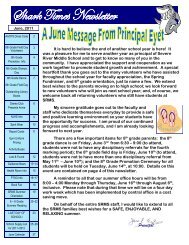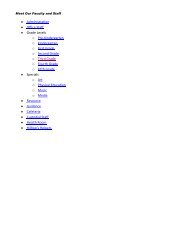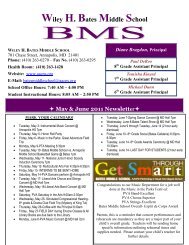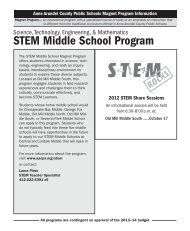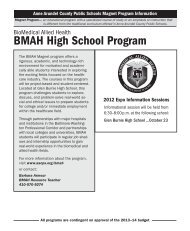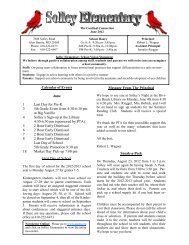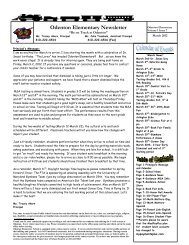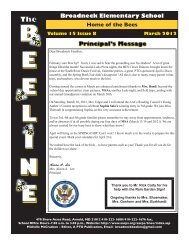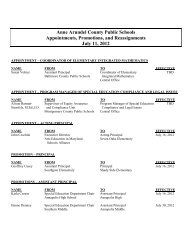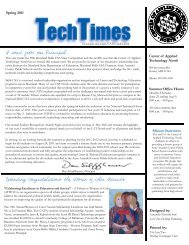Student Handbook - Anne Arundel County Public Schools
Student Handbook - Anne Arundel County Public Schools
Student Handbook - Anne Arundel County Public Schools
You also want an ePaper? Increase the reach of your titles
YUMPU automatically turns print PDFs into web optimized ePapers that Google loves.
26 <strong>Anne</strong> <strong>Arundel</strong> <strong>County</strong> <strong>Public</strong> <strong>Schools</strong> • 2012–13 <strong>Student</strong> <strong>Handbook</strong><br />
Glossary, continued<br />
Bullying<br />
Repeated, conscious, willful and deliberate intent,<br />
direct or indirect, to physically or psychologically<br />
intimidate or distress someone else; physical,<br />
social, or verbal actions or intimidation toward<br />
another person with negative intent. (See also<br />
Cyber-bullying, Relational Bullying)<br />
Bystanders<br />
Individuals who observe bullying, cyberbullying,<br />
harassment and Intimidation, hazing, and bias<br />
behavior and who, by their inaction, encourage,<br />
support, or promote its occurrence.<br />
Cell Phone Misuse<br />
Use of cellular phone, camera phone, video<br />
phone, or other communication devices during<br />
the school day or on school buses unless in<br />
an emergency. (Instructional uses of mobile<br />
devices that are sanctioned by AACPS must be<br />
accompanied by parent/teacher Acceptable Use<br />
Policy forms that are<br />
kept on file within the school).<br />
(See also Electronic Devices Misuse)<br />
Cheating<br />
Providing, receiving, or viewing answers to quiz<br />
or test items or independent assignments.<br />
Having books, notes/notebook, or mobile<br />
devices out during test without permission.<br />
Cutting Class<br />
Unlawful absence from a class or school<br />
activity. (See Absences, unlawful)<br />
Community Service<br />
An unpaid service for the benefit of the<br />
public that is performed as part (or all) of a<br />
consequence for committing an infraction.<br />
Computer misuse<br />
Any unauthorized or inappropriate use of<br />
technology-related resources.<br />
Category I<br />
• Intentionally loading/distributing a virus,<br />
malware, malicious program<br />
• Installing/running/using/distributing a<br />
keystroke logger program (used to capture<br />
logon credentials/passwords/PINS, etc.<br />
• Possession of a keystroke logger Including on<br />
portable media<br />
• Using or attempting to use credentials other<br />
than your own<br />
• Altering or attempting to alter grades/any<br />
school record. Includes attendance, test scores<br />
• Theft of hardware or components/parts<br />
• Changing configuration(s) on network equipment.<br />
Includes servers, switches, and routers<br />
Category II<br />
• Intentional physical damage to computers<br />
• Intentional damage to network includes data<br />
jacks, cabling, racks<br />
• Changing configuration(s) on computers,<br />
workstations, printers<br />
• Running/distributing network scanners in an<br />
attempt to discover network resources (i.e. port<br />
scans, ip address scans)<br />
Category III<br />
• Installing Unauthorized programs on AACPS<br />
hardware. Storing Unauthorized programs on<br />
AACPS equipment (home directory). (Defined<br />
as non-malicious software not approved for<br />
use in AACPS)<br />
• Using/distributing a proxy application<br />
(circumvents web filtering and security)<br />
• Using/distributing a proxy site (circumvents<br />
web filtering and security)<br />
• Using the network to access or store Inappropriate<br />
content (music, photos, videos, etc.)<br />
Category IV<br />
• Running/distributing unauthorized programs<br />
including from portable media, i.e., games<br />
(defined as non-malicious software not<br />
approved for use in AACPS). Includes<br />
distribution of unauthorized programs.<br />
• Playing unsanctioned online games without<br />
authorization from teacher/administrator<br />
• Streaming non-instructional media<br />
(i.e. ,music, video, online content)<br />
• Non-instructional electronic activity during<br />
class (i.e., chat rooms, messaging, etc.)<br />
Conditional Reinstatement Contract<br />
A contract developed by school administrators or<br />
Central Office staff outlining student academic<br />
and behavioral expectations.<br />
Conference<br />
A communication that takes place either faceto-face<br />
or by telephone.<br />
Consequence<br />
A result that follows from an action<br />
or condition.<br />
Criminal Behavior<br />
Any behavior that is considered an infraction<br />
against the law.<br />
Cyber-bullying<br />
The use of information and communication<br />
technologies — email, mobile devices, text<br />
messages, instant messaging, defamatory<br />
personal websites, personal polling sites, or a<br />
combination of these — to support deliberate,<br />
repeated, and hostile behavior by an individual<br />
or group with the intention of physically or<br />
psychologically intimidating others. (See also<br />
Bullying)<br />
Dangerous Implements<br />
Any implement or substance used as a weapon<br />
to inflict bodily harm, including any object or<br />
implement capable of causing harm or used in<br />
such a way as to cause harm to another. This<br />
includes, but is not limited to, laser pointers,<br />
pencils, and scissors.<br />
Demonstration and Mass Protest<br />
Willful disturbance of school activities through<br />
a march or rally that prevents the orderly<br />
conduct of school classes<br />
or activities.<br />
Destruction of Property/Vandalism<br />
Damage, destruction, or defacement of property<br />
belonging to the school or others.<br />
Disrespect Toward Others<br />
Inappropriate comments or physical gestures<br />
to others.<br />
Disruption to Classroom or School<br />
Behavior (including possession of toys at<br />
the elementary level) that interferes with<br />
instruction, learning, and a safe and orderly<br />
environment, which includes, but is not limited<br />
to, chronic talking, throwing objects, horseplay,<br />
teasing, refusal to remain in seat, rude noises,<br />
selling items on campus, etc.<br />
Disruptive Clothing or Appearance<br />
Articles of personal appearance that may create<br />
a significant risk of a material and substantial<br />
disruption to the educational process or the<br />
operation of the school. This includes, but is not<br />
limited to, clothing, hats, jewelry, book bags, or<br />
other articles of personal appearance which<br />
depict profanity, vulgarity, obscenity, violence,<br />
symbols of hate, or promote use or abuse of<br />
tobacco, alcohol, or other drugs, gang colors<br />
or gang-related signs on personal or school<br />
material.<br />
Additionally, except in individual cases as<br />
approved by the principal of a school, the<br />
following specific items are not permitted: bare<br />
feet, hats, caps, hoods, chains, spikes, or other<br />
head wear except as required for health, safety,<br />
or religious purposes, and clothing worn in such<br />
a manner so as to reveal underwear or bare skin<br />
between the upper chest and mid-thigh.<br />
Due Process<br />
A student facing suspension must be given<br />
oral or written notice of the allegations, an<br />
opportunity to hear the evidence, to respond if<br />
the student denies the allegations, and notice



